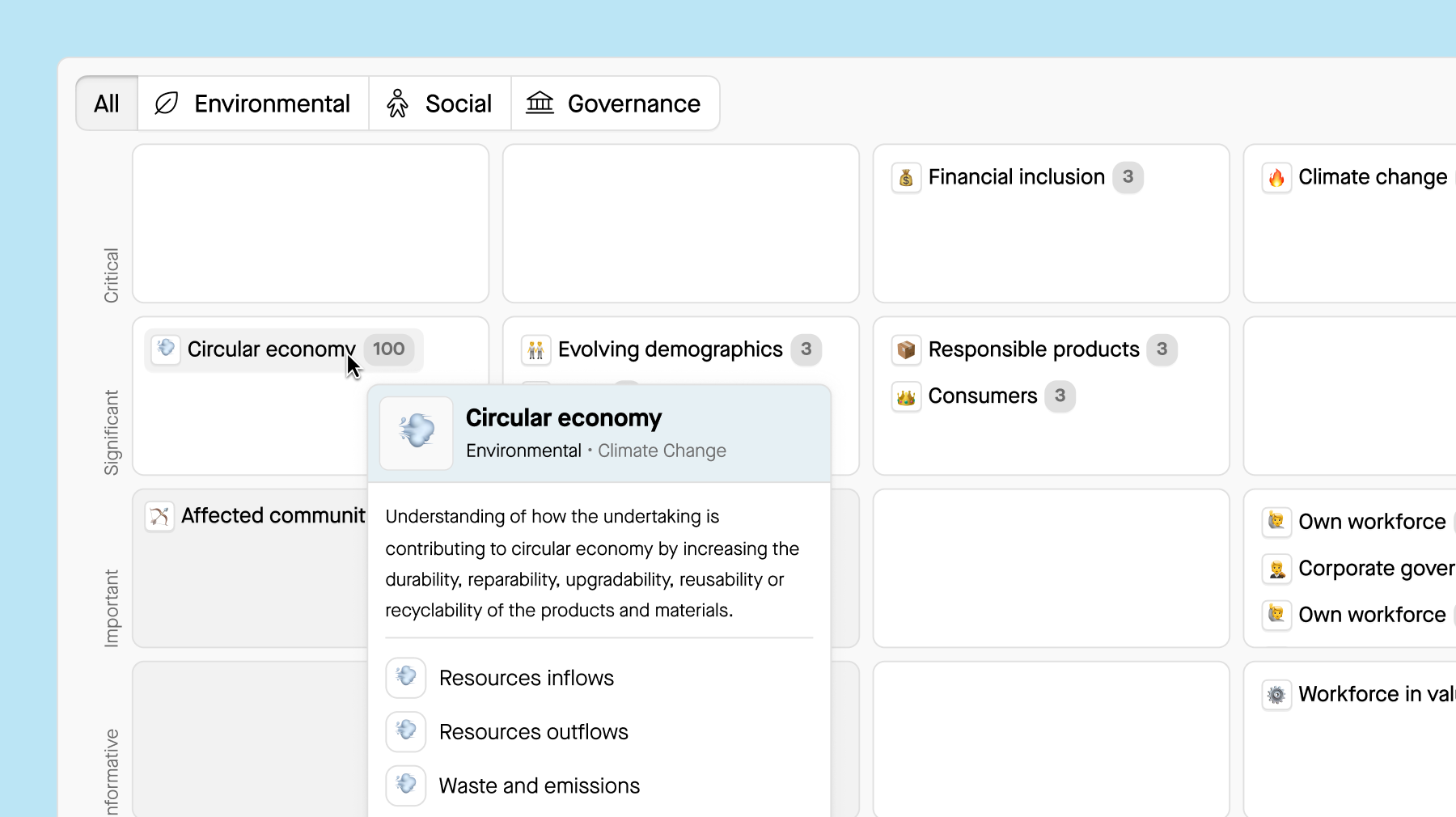Your journey to CSRD compliance doesn't have to be complicated. We've compiled a handy checklist to outline what you need to do at every step – with resources to support you.
CSRD Readiness checklist

An easier journey to CSRD compliance
1. Lay the groundwork
a) Conduct a first materiality assessment
-
Familiarize yourself with the concept of double materiality, which is key to the CSRD.
What is 'double materiality'?
Double materiality recognizes the interdependence of financial materiality (the impact of ESG factors on your organization's financial performance) and ESG materiality (the impact of your organization's activities on the environment, society, and governance).
-
Assess which ESG factors impact your company’s financial performance.
-
Assess which of your business activities impact the environment, society, and governance.
Note that this is just an initial assessment. Next, you’ll complete a thorough double materiality assessment.
b) Plan which stakeholders to involve in your thorough materiality assessment
-
Determine which internal colleagues should be involved in setting topics for a thorough double materiality assessment – including evaluating impacts, risks, and opportunities.
-
Determine which external stakeholders should be included – these should be people or groups who are most affected by your company’s actions.
-
Begin stakeholder discussions about the key issues for your materiality assessment.
Reporting on stakeholder involvement
Compliance with the CSRD necessitates reporting on stakeholder involvement, which means that you’ll need a tailored approach to gathering feedback, both internally and externally. Establish mechanisms for anonymous issue reporting, as mandated by the CSRD. Kickstart stakeholder engagement plans and integrate feedback iteratively into the double materiality assessment process, avoiding the common pitfall of delaying writing the first draft of the assessment while completing stakeholder dialogues.
How Sweep can help
-
Sweep gives you access to a benchmarked double materiality matrix, tailored to the sectors in which you operate.
-
Easily benchmark your data against SASB and ENCORE.
-
Refine and/or import your matrix if you’ve already created it.
2. Conduct your full materiality assessment
a) List the relevant Sustainability Issues
-
Create a list of all the ESG issues that are relevant to your business.
-
Assess the impact that your company has on each of these issues using the data gathered from your stakeholders (point 1).
b) Map out your risks
-
Establish a robust risk management framework enabling proactive management of significant topics.
-
Record the risks and opportunities linked to ESG pertinent to your business operations.
c) Create a framework listing the most material issues
-
Estimate the scale, scope, irremediability and likelihood of each issue identified, using a score for each of these four criteria.
-
Prioritize the issues based on the given score.
Use ESG reporting software
Note that ESG reporting software is very useful in helping you to keep track of all the identified issues and the risks associated with them.
A note on ‘materiality’
Materiality in the context of sustainability refers to the significance of an issue or topic in relation to its potential impact on society and business value. While there isn't a precise quantitative definition, the EU emphasizes that an issue is considered more material if it poses a higher severity and has a greater likelihood of affecting stakeholders. Severity is determined by factors such as scale, measuring the extent of the issue, scope, assessing its reach or the number of people affected, and irremediability, indicating whether the issue can be resolved over time.
How Sweep can help
-
Easily update your materiality assessment with Sweep in line with your reporting cycles.
-
Justify and document your choices, at topic level and/or disclosure indicator level.
3. Map out your sustainability strategy
-
Establish policies to direct efforts on material topics.
-
Specify targets, including milestones and deadlines, for each material topic.
-
Outline necessary actions to achieve the defined targets.
-
Allocate responsibilities for actions to respective owners.
-
Progress and refine iteratively.
CSRD specifications on sustainability policies
Under the CSRD, companies need to create rules (called policies) that guide how they deal with important sustainability issues. These rules should include goals, who's responsible for what, and how they consider the needs of everyone involved.
Also, businesses must come up with ways to measure their impact on these issues and set specific goals to improve. These goals need to have clear deadlines and be easy to measure to make sure they're making progress as required by the CSRD.
How Sweep can help
-
Sweep comes with ready-to-use surveys for all environmental, social and governance indicators. You can also re-use data from your GHG Protocol reports, so you can avoid collecting the same data twice. You can also manually upload your data.
-
The platform can connect with dozens of IT Systems, to automate data collection in near real time.
4. Check for missing data
-
Perform a data gap analysis to identify any deficiencies in the data necessary for tracking progress towards your defined targets.
-
Take steps to address data gaps or quality issues, ensuring that all required data is available and accurate.
-
Implement measures to obtain missing data and improve data quality where necessary, enhancing the reliability of your monitoring process.
How Sweep can help
-
Sweep monitors the data collection progress for all ESRS disclosure requirements and indicators. It allows you to see whether the responses have been reported, approved, or left unanswered.
-
You can utilize it to send reminders or use extrapolation to fill data gaps and complete the campaigns process.
5. Report on your progress
-
Schedule regular progress discussions to ensure accountability and alignment with targets, fostering a culture of responsibility.
-
Maintain ongoing oversight of delegated actions, tracking completion and addressing any outstanding tasks to keep initiatives on track.
-
Initiate discussions with auditors promptly to secure a third-party verification source before your deadline.
-
Incorporate change logs featuring audit-compliant user roles and permissions.
-
Submit your report to the ESMA – Digitally tag your indicators to prepare your report in the XHTML format. This makes it machine-readable for use in the European Single Access Point (ESAP).
How Sweep can help
-
Make sure your data is accurate by using quality controls. See any errors, duplicates, and irregularities in your dataset and correct them.
-
Keep an eye on every change in your data. You can comment and keep track of all changes across the platform, along with the related documents.
-
Automatic checks let you know if there's anything unusual in your datasets, like anomalies or duplicates.
-
Sweep makes both internal and external audits easier with an auditor profile. This gives them quick access to all the data history and relevant documents.
Use Sweep to become an CSRD Compliance Champion
Sweep can help
Sweep is a carbon and ESG management platform that empowers businesses to meet their sustainability goals.
Using our platform, you can:
- Conduct a thorough assessment of your carbon footprint.
- Get a real-time overview of your supply chain and ensure that your suppliers meet your sustainability targets.
- Reach full compliance with the CSRD and other key ESG legislation in a matter of weeks.
- Ensure your sustainability information is reliable by having it verified by a third party before going public.








